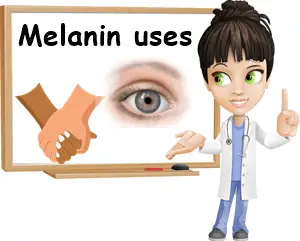What is melanin? By definition, melanin is a pigment found in the skin, eyes, hair and even ears and brain tissue. It’s produced by special cells called melanocytes and stored in sacs (vesicles) within the melanocytes called melanosomes.
The pigment can be transported by the melanosomes to adjacent cells such as skin cells to serve its various purposes. For example, when exposure to sunlight occurs, the melanosomes develop temporary projections to reach nearby skin cells and pass on the pigment, which is also what initiates the tanning process.
What is melanin used for?
The pigment absorbs sunlight and functions as a UVA and UVB repellent. It basically catches the light that reaches the skin and dissipates UVA and UVB rays, protecting against molecular damage. The photoprotective effects extend to eyes as well. So the biggest benefits of melanin are counteracting skin and eye damage from sun exposure, anti-aging effects and protection against skin cancer (although not 100% effective). Melanocytes, the cells the produce the pigment, also serve as immune system cells and can activate the immune system response through various actions.
Find out more about all the wonderful benefits of melanin.

How does melanin affect skin color?
Melanocytes, the cells that produce the pigment, are located at the base of the top layer of the skin (the epidermis). In response to sunlight exposure, these cells produce pigment which is transferred to skin cells and essentially affects their color. Depending on skin color, effects may range from darkening (in light skin) to no visible changes (in dark skin).
But even though no visible tanning occurs in dark skin tones, melanin is still produced. In fact, the process continues for the duration of the sunlight exposure because the pigment is supposed to function as a photoprotective barrier and prevent skin damage. What melanin further does is repair damaged skin to counteract premature skin aging (wrinkles, age spots) and sun damage (sunburns, skin cancers).
What is the relationship between melanin and hair color?
Different people are affected differently by the pigment melanin. Also, not everyone produces the same types of melanin in the same amounts which explains all the wonderful variations in skin, eye and hair color.
Skin tone and hair color are determined by varying amounts of brown and black eumelanin and red-orange pheomelanin pigments.
Brown and black eumelanin are largely responsible for the entire range of light to dark skin tones and blonde to brown to black hair colors. Pheomelanin on the other hand gives areas such as the lips their red-pink coloration and is a dominant type of melanin in red hair. Blonde hair has little overall pigment, whereas dark brown and black hair are rich in pigment. Red hair doesn’t have much pigment either and gray and white hair very little to none.
Just as interesting, not all strands of hair are the same color, even in the seemingly most uniform hair colors. Some hairs get their pigment from brown eumelanin, others from black eumelanin and others from red pheomelanin. And since the amount of pigment produced by melanocytes at the base of the hair root may vary, there is room for even greater variation in hair color.

A lot of people are looking to reverse hair graying or improve the appearance of an uneven skin tone, whether it’s hyperpigmentation such as in melasma, under-pigmentation such as in vitiligo or various blemishes or spots. And because melanin is what gives skin, hair and eyes their color, they are looking for supplements that contain the pigment.
In reality, there is no such thing as a melanin supplement because melanin cannot be harvested and bottled. It’s a pigment produced in the human body in response to sunlight exposure and its production is closely regulated by intricate cellular processes.
There are however supplements that supposedly initiate, reduce or increase melanin production for the purpose of skin bleaching or darkening or the reversal of gray hair. But don’t expect them to deliver such effects. At most, melanin supplements may contain various nutrients known or thought to be involved in the production of the pigment such as the amino acid tyrosine.
Indeed, tyrosine is a precursor of the pigment (melanin is made from it). But irrespective of how much or little of the amino acid you are getting, that won’t just change your skin or hair pigmentation. As a side-note, if you are eating enough protein, then you are likely getting enough tyrosine, so no need to supplement with it.
Some melanin supplements contain beta-carotene or other carotenoid precursors of vitamin A which are known to impart an orange, tan-like hue to skin. This is also not going to affect melanin production in any way because you cannot directly increase melanin production with vitamins. At most, vitamins commonly found in supplements that claim to increase melanin production (vitamins A, C, E) have antioxidant and anti-aging properties, offer a certain level of protection against skin damage and help reverse sun damage, to a limited extent of course
Vitamin A does oversee skin cell formation and differentiation which holds positive effects for skin health, but doesn’t actually do anything about increasing pigmentation. Overall, the melanin production process is too complex to be mediated simply by ingesting an amino acid or a vitamin.
There isn’t a melanin blocker type of supplement either. For people with a light and medium complexion, simply avoiding sun exposure is enough to limit melanin production and achieve a lighter, paler skin tone, or return to their natural one. Of course, absolute avoidance is not a healthy practice since we need sun exposure for the production of vitamin D and a wide range of health benefits, from stronger bones and teeth and good fertility to a strong immune system.
Difference Between Melanin and Melatonin
Also, don’t confuse melanin with melatonin, a hormone harvested from animals and typically used as a supplement for inducing sleep, regulating sleep cycles and temporarily treating sleep disorders. Overall, it’s important to understand that melanin production is a sort of real-time process that occurs in response to sunlight exposure and is tailored according to our individual requirements for the main purpose of photoprotection. The skin, eye and hair pigmentation it produces is the result of millions of years of evolution meant to keep us healthier, whatever the environment and amount of sunshine available.
